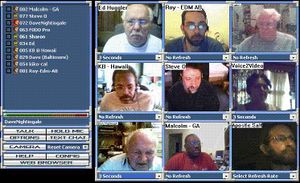Difference between revisions of "Video conferencing"
From E-Consultation Guide
(→Video conferenced chats) |
|||
| Line 12: | Line 12: | ||
**Discussions with key stakeholders who cannot meet in the same place. | **Discussions with key stakeholders who cannot meet in the same place. | ||
*Software | *Software | ||
| + | **Simple video conferencing software can be free of charge, e.g. | ||
**Some of the [[VOIP]] tools, like Skype or Windows Messenger now support video. | **Some of the [[VOIP]] tools, like Skype or Windows Messenger now support video. | ||
**[http://www.conferencexp.net/ Microsoft ConferenceXP] (as illustrated) | **[http://www.conferencexp.net/ Microsoft ConferenceXP] (as illustrated) | ||
Revision as of 21:42, 17 July 2006
It is possible to compess video recordings and send the files across the Internet. This is the technology behind the online video download sites, like YouTube.
Small images can be streamed in real time, as they are recorded. There are three communications situations:
Video conferenced chats
- Experience
- Everyone has a microphone, speakers or earphones and a web cam.
- They can see small images of everyone else, as shown in the screenshot on the right.
- They take turns to speak, discussing a topic among a small group.
- Consultation applications
- Online focus groups with illiterates.
- Discussions with key stakeholders who cannot meet in the same place.
- Software
- Simple video conferencing software can be free of charge, e.g.
- Some of the VOIP tools, like Skype or Windows Messenger now support video.
- Microsoft ConferenceXP (as illustrated)
- Ekiga (formerly GnomeMeeting)
- OpenH323 project
Webcasting
- Experience
- One video is streamed to many viewers, such as in Internet broadcasts of parliamentary committees.
- Questions to the speaker come back though another channel, perhaps by typing them into IRC or a chat room.
- Consultation applications
- Letting more people look in on a face-to-face hearing or conference.
- On-line public meetings, a video presentation followed by answered questions texted back.
- Software
- There are many programs that will compress video and stream it over the Internet, but you need to pick one that your viewers' computers can play. There are competing containers for video (MPEG, AVI, Quicktime, Real Audio, Windows Media, Macromedia Flash, ...) and competing ways of compressing the audio and video, using different codecs. So start by surveying potential users and finding out what they can view.
- If all else fails, you can try the low bandwidth solution of Democaster. It doesn't attempt to stream the video. Instead it streams audio, synchronised with still images taken every 10 or 20 s.
Video conferenced e-meetings
- Experience
- The main speaker is broadcast to others, who see the speaker and/or his presentation slides.
- Questions come back via video, audio or text, all integrated in the same software.
- Often there are shared whiteboards or documents, so that people can work together.
- See a simulation of a Breeze meeting
- Consultation applications
- Software
- Sophisticated E-meeting software integrates many functions in one product. It is often expensive. You might pay £5000 to £10000 for your own installation of a video conferencing server. Consequently, many companies host the video conferencing software for you, and let you hire it by the hour.
- Macromedia Breeze
- MarraTech
- OnlineMeetingRooms
- MegaMeeting
- WebEx
